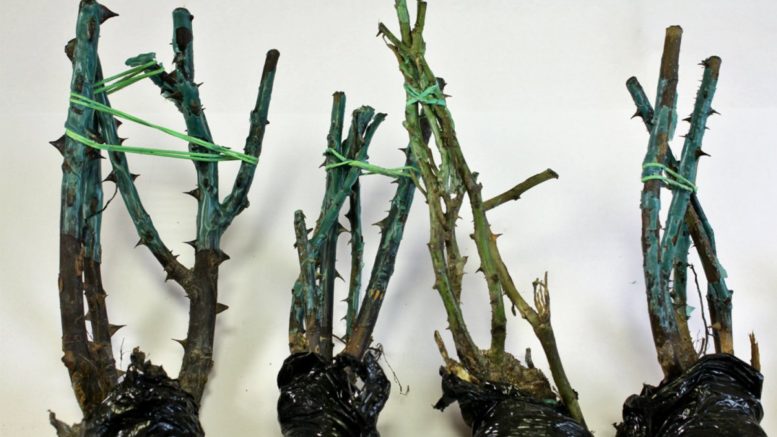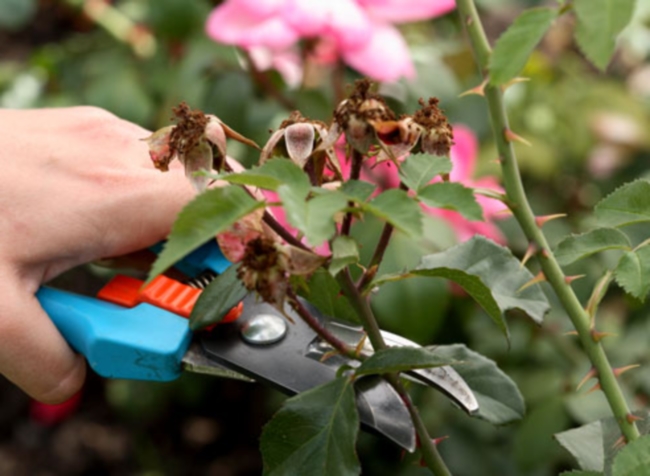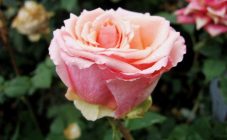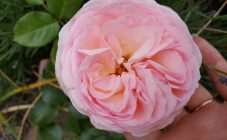Content:
L D Braithwaite - a modern English garden rose, belongs to the class of scrubs (shrubs). Resistant to disease and cold, loves a sunny place and fertile soil.
History of creation
Rose Al Dee Braithwaite refers to the selection of David Austin. The goal of the breeder was to create flowers that looked like bush roses and would bloom repeatedly under different conditions. In 1961 he crossed Bel Isis and Le Grasse. The result was the first Constance Spray, which resembled a peony and exuded a myrrh scent.
In 1984 Austin introduced 50 varieties of new English roses. They were obtained as a result of repeated crossing of old varieties with floribunda, hybrid tea rose and wild rose hips.
Currently, 12 of Austin's finest rose varieties have received the British Royal Horticultural Society's seal of excellence. New items constantly appear in the catalog of his roses.
general information
Rose Lord Bracewaite is endowed with the most intense red buds of all varieties of English roses. The flowers are double, wide open. Inside the flower there are small swirls of small petals. The rose is very reminiscent of a lush peony.
Flowering occurs throughout the summer. They begin to bloom from mid-June to late summer. The buds appear quickly and bloom for a long time on the bush. The aroma is very strong. There are few leaves on the bush, they are glossy, large and have a rich green color. The stems of the plant are very strong, they will not bend under a lush flower.
The size of the bush is low and wide. This rose is best planted in groups, since alone its bush does not look very lush and beautiful due to the small amount of foliage.
Description:
- height 90-100 cm;
- width 100 cm;
- flower diameter 10 cm;
- flowering is repeated;
- flowers are large, double, collected in a cup-shaped rosette, in one flower from 85 to 95 petals.
The variety is popular among Russian gardeners, as it tolerates winter well and is rarely susceptible to diseases and pests. However, the plant must be covered for the winter. Also, the flower does not tolerate rain very well, but it has a high resistance to fading in direct sunlight.
Growing features
It is better to buy seedlings from leading breeding companies. They will provide complete and reliable information about the quality of their planting material. Roses are usually offered with open roots, as this promotes better survival. During the purchase, you should carefully examine the stalk. It should be smooth, free from cracks, the stems should have a uniform green color, the cuts on the roots should be white. The roots should be elastic and the seedling should have 2-3 stems. In the springtime, seedlings are offered with buds that sleep. You cannot buy seedlings that are dry, have spots or black dots on the stems, wrinkled bark and black leaves.
The agricultural technology of growing roses of English origin is practically no different from the agricultural technology of other shrub varieties.
Roses LD Brightwhite are able to grow in one place for several decades. However, the site must be carefully prepared before landing. It needs to be sunny. The soil in which the plant is planted must be drained, nutritious and neutral. The roots of the plant should not be dry before planting. To do this, they are soaked by adding growth stimulants to the water.
To plant a Brightwhite rose, follow these steps:
- Dig a hole for planting, the dimensions of which are 60 × 60 cm, depth 50 cm;
- The top layer of soil must be left next to the pit, and the bottom layer must be removed;
- Since the soil for planting a rose L D Braithwaite must be fertile, loose and with a neutral reaction, humus, vermicompost and rotted compost must be added to its top layer. To reduce the acidity of the soil, you can additionally add such additives as: wood ash, dolomite flour;
- If the soils are heavy, add sand;
- All ingredients are thoroughly mixed and placed in the planting pit.
Planting depth depends on some features.
If a rose is grafted onto a rosehip
If it is necessary to preserve the roots of the rose hips, the grafting level should be 2-3 cm from the soil. In winter, the vaccination site must be covered so that the plant does not die and does not grow into a rosehip. Periodically, the rose hips are cut off. With this planting, very often the dog rose occupies a dominant position and the rose variety disappears. Therefore, such roses must be carefully looked after.
If a decision is made to transfer the rose to its own roots, the planting depth should be from 5 to 17 cm. The duration of the transfer to its own roots is from 3 months to one and a half years. From frost during the transition, cover with light cover. Further, the soil is mulched 3-5 cm from the bark.
If roses have their own roots
Such seedlings are planted in a hole in such a way that there is about 15 cm of the board above the planting level in the hole. For the winter period in the first year, seedlings are mulched in the hole with chips, bark, shavings or foliage. Cover from above with a board, glass or polycarbonate sheet. The next year, a special fertile soil is poured into the hole. It can be found in gardening stores. The result is a very strong rose with its own root system. In the second year, for the winter, the bush is only mulched.
Starting from two years old, a rose with its own roots is planted without worrying about the depth of planting.
Brycewaite roses are demanding to care for. Top dressing should be balanced. The soil must contain all the necessary substances or come in the form of top dressing. Top dressing of a rose can be done in two ways:
- For those who prefer organic farming, it is sufficient to add wood ash and horn-hoof meal during planting. Also, annually mulch with compost or rotted manure;
- For those who allow the introduction of mineral fertilizers, it is possible to use special liquid dressings for roses once every 10-14 days. This fertilization can be carried out until the twentieth of June.
In August and September, nitrogen should not be present in the dressings. This is necessary to stop vegetative growth, improve the ripening of shoots, and strengthen the bush for winter.
For the formation of powerful shoots, pruning of the bush is necessary. Some pruning rules:
- the best time for pruning is April, when the buds have not yet blossomed. If you trim the flower later, after the young shoots begin to grow, this will postpone the flowering time;
- small and weak shoots are removed, due to the fact that they rarely bloom. Sick and underdeveloped stems are also removed;
- the formation of a bush is performed depending on its purpose. To keep the bush small, the stems are shortened in half. To get a large bush, pruning is done by a third.
- it should also be borne in mind that the shoots of the bush are drooping, therefore additional supports are used when growing.
Bracewaite roses are a shrub type. Their shoots fall beautifully to the ground. Due to the abundant flowering of the variety, roses are used in landscape design to create flower beds. At the bottom of the bush, you can plant Heucheras and Hosts.
Rose disease
Despite the good resistance to diseases, roses of this variety, when weather conditions deteriorate, can get sick with black spot or powdery mildew.
To prevent the plant from powdery mildew, the plant is treated with sour milk whey.
If there is more frequent rain and cold snaps at night in the second half of summer, the risk of infection with black spot increases. Systemic drugs will help to fight the disease. For prevention, the bushes are treated for the first time after the leaves bloom. Then processing is carried out in May-June. During the processing period, it is necessary to choose a day when there will be no rain for at least five hours. At this time, the drug is well absorbed into the leaves and will protect them for two weeks.
Shake the plants after rain to remove excess water and prevent gray mold from forming.
Advantages and disadvantages
The advantages of Braithwaite roses include:
- pleasant strong aroma;
- long flowering period;
- good winter tolerance in Russia;
- can tolerate shade;
- flowers form all over the stem;
- flowers have a unique shape that differs from other species.
The disadvantages of this variety include:
- poor resistance to atmospheric precipitation;
- poor tolerance to hot weather: flowers become small and crumble;
- the plant sometimes gets sick with black spot;
- young plants may wither under the weight of the buds.
Rose Brightwhite is doing well in the Russian climate. The rose is capricious in its own way, but if you follow certain rules of care, then it will delight its owner-gardener with beautiful red flowers.
















